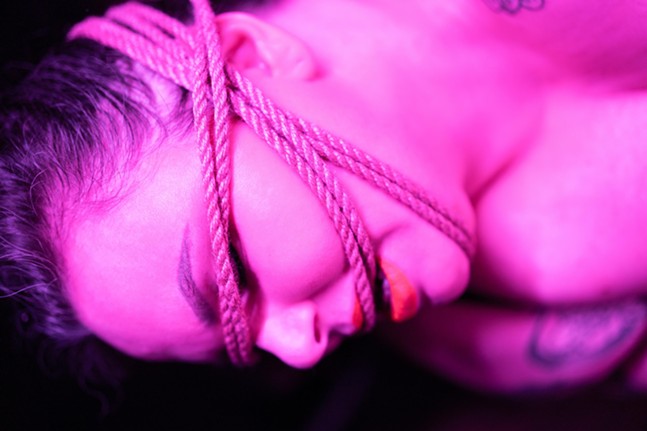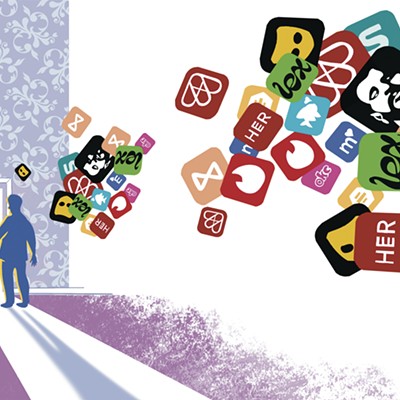One of the great pleasures of my work — as both a sex writer and a sex worker — has been the close proximity I’ve been granted to other peoples’ desires, things that I would have never thought to explore or find erotic on my own. Hundreds (perhaps thousands) of hours on phone sex lines, interviewing sex radicals, and performing a vast array of fantasies for clients has shown me that sex can take as many forms as we can imagine.
Several weeks ago, when my editor asked me if I was interested in writing this piece about Shibari — the decorative art of rope bondage that originally came out of Japan, but that has also made its way into American BDSM circles — I was reminded of how varied sexual desire and satisfaction is. Though I have seen live rope demonstrations, have friends who engage in Shibari, and have talked clients through the aftermath of being bound, I never personally understood why anyone would take the time to learn how to tie rope intricately or sit still long enough to be bound by it. “I have too much ADHD to be able to do that myself,” I told her. “But I’ll interview people who are into it.”
I am not the only person who didn’t immediately understand the appeal of rope bondage. Even someone deep in the rope scene, like Russ (he/him), the founder of Rope Bite Pgh, a Pittsburgh-based group dedicated to sharing educational information and community around rope bondage, was perplexed by it at first. “I'd always been interested in kink, but I didn’t understand rope when you could just slap on a leather cuff and get to whatever else you're doing,” he tells me over Zoom. Indeed, this was my question, too. How patient do you have to be to sit through an elaborate rope-tying ritual before getting to the “whatever else”?
But to think this way is to entirely miss the point of Shibari, which, in Japanese, means “to tie.” In traditional Shibari practice, tying is its own end, and the pleasure, pain, and beauty are found in the practice itself, not in whatever happens once the rope bottom (the person being tied) has been securely bound.
Christophe Ngo (he/him), a Licensed Marriage and Family Therapist (LMFT) specializing in sex therapy, trauma, and identity encountered Shibari the first time he went to a dungeon. He remembers being fascinated by it. After a live demonstration by a husband and wife team, he went up to the couple and asked, “So help me understand Shibari. What do you both gain from this?”
The wife — the rope bottom in this context — described herself to Ngo as dominant in every other aspect of her life and said that, because her job is high profile and high stress, she has a hard time letting go. She explained, “When I’m being suspended [hung with rope, a common practice in Shibari] or tied up, the more I resist, the harder it gets.” In other words, the rules that govern the rest of her life don’t work when she’s rope bottoming; the more she tries to remain in control, the more uncomfortable the process is. She is forced to let go. “Because she lets go, she can enjoy,” Ngo says.
Since that first introduction to Shibari, Ngo has had similar experiences as a rope bottom. He says, “It's nice when I get to be a pillow princess and someone's doing it for me and I'm just going to relax, and focus on the rope.” He describes this experience as having a therapeutic quality. He says, “It doesn't have to involve [sexual] stimulus or anything. You just have to be present to the sensation and allow the body to relax, it can heal itself in the process.”
This is a common story in BDSM. Those in positions of power feel relieved when they can relinquish some of their control in the form of play. Indeed, my clients who hunger for submission are often the ones who wield the most power outside of our dynamic.
But this is not the only story. Celeste Pietrusza, Ph. D. (she/they), a clinical psychologist with a concentration on BDSM and kink, says, “There is often an element of being cared for, knowing that an experienced, responsible top has you.” The appeal of “letting go” can also look like entrusting another person with your care, which can be especially powerful for people with trauma histories that have undermined their capacity to do this.
Yet, one doesn’t need rope to submit. Going back to Russ’ original question, why not just use leather cuffs as a shortcut if submission is the goal? I reached out to Philadelphia-based professional submissive Hunny Daniels (they/them) for an answer to this question. They could hardly contain the unabashed joy they experience being bound by Shibari rope (typically made of jute or hemp). “I have sensory-seeking autism, for sure,” they explain. “A lot of my time is spent trying to gain a feeling. I'm trying to experience something specific; it's not always easy out in the world to acquire those sensations.” Rope bondage, though, delivers the sensory experience Daniels craves. “When I’m being tied, I feel the restriction and it’s really calming and comforting,” they say. “It’s a prolonged sensation that is just what I desire.”
Daniels’ neurodivergence isn’t out of the ordinary in kink spaces. “Temple Grandin talks about the experience of being held, which is so calming to her with autism,” recalls Pietrusza. “What I've found with many people who engage in rope bondage when they are neurodivergent and kinky is that they enjoy that feeling of being held or contained.”
Melissa Milk (they/them), a Pittsburgh-based member of the kink community who has been both a rope bottom and top (commonly referred to as a “rigger”), says, “I believe that most of the people who do rope bondage are doing it because they're neurodivergent or have experienced trauma in a way that leads them into these spaces.” Milk is no exception to this. “I have ADHD, and I’m super easily distracted,” they say. But rope helped Milk quiet some of those distractions. “It was really easy to make rope my hyperfocus,” they say. “I learned to tie really quickly.”
Certainly, not everyone who participates in rope bondage (or kink more broadly) is neurodivergent, but hearing neurodivergent people talk about the way Shibari has met their needs differently than other forms of sexuality started to shift my perspective. Was my original impulse based on a misunderstanding of what the experience of Shibari is?
What appears, from the outside, to be very slow and tedious was being described by my interviewees as an all-consuming dance involving both pain and pleasure — one that quiets the distraction and noise of the world outside the scene. They were describing the sort of self-contained intimacy that I work so hard to create for my clients in the context of a session — an intimacy that pushes the cares of the world away, if only for an hour.
On a Zoom call, long-time rigger Sir C (she/her), who has been doing rope bondage since 1999, tells me, “I was drawn to rope because of the artistry, the control, and the collaborative nature.” And this artistic collaboration — this dance — seems to occupy center stage for everyone I talked to. A partnered dance seems to be the perfect metaphor because it implies both skill and connection. Pietrusza suggests, “Each tie can be a moment to really form a connection.”
Sir C sees the training and skill of the top to be one of the conditions for the possibility of this intimacy. “The skill part of it is important so that you don’t have to focus on the ties,” she says. “You’re doing that almost instinctively so that you can focus on your connection with the rope bottom.” For Milk, the importance of this connectivity with their partner is what sharpens their focus. They say, “Even as a top, any distractions pretty much completely melt away. The activity you’re doing commands all your focus. I couldn’t do the type of topping that I do without being 100% focused on my partner.”
It would be easy to think about the rigger as engaging in an active practice while the bottom passively allows it, but Sir C reminds us of the engagement required of the bottom. “Bottoming for rope is a very active process,” she says. “The bottoms have to manage their bodies, their headspace, their muscles. It’s a much more active bottoming than, say, standing to take a beating.”
I wouldn’t do the sort of work I do if I didn’t believe that engaging with the desires of others has the power to change me. I look for that in every interaction that I have. But I am usually capable of understanding something on an intellectual or emotional level without having to experience it myself. I wasn’t prepared, in other words, for the ways that doing these interviews would make me long for the sort of still concentration that Milk spoke of, the cathartic sensory experience that Daniels and Ngo described, and the confident, connected know-how that both Russ and Sir C radiated. Indeed, the activity that once looked boring and technical to me became so compelling that I invited Milk to my house to help me experience a suspension for the first time.
Like any responsible and knowledgeable top, Milk came in with a list of questions about my previous experiences with bondage and kink, my associations with eroticized pain (in the words of Sir C, “There is no way to be comfortably suspended”), and the idiosyncrasies of my body. They then explained the risks, what I may experience during the suspension and in its aftermath, and how to communicate my limits should we hit up against them. And then they started to wrap rope around my body, tightening it with each loop.
I cannot tell you what happened next. Not because I blacked out (I did not), but because I haven’t had enough time to process the experience of being lifted off the ground and held by what felt like a dozen pressure points. I also don’t yet have the words to describe the feeling of being slowly lowered while the tight rope slackened and my body melted onto the floor.
What I can tell you is that later, when Milk tied me to the white chase that my partner and I mostly use as a photoshoot prop, I consented to have my neck bitten and my thighs scratched and all I could think as it was happening was, “More.” What I can also tell you is that when it was over, my partner told me that I sounded like I was cumming as I moved through the scene — but I hadn’t noticed that I was making noise at all.
What I did not experience is the sort of boredom and ADHD inattentiveness that I had previously associated with the form. I understand now how Russ could go from asking the same sort of questions as me to founding a group that created community and classes around the art.
“Rope,” Pietrusza tells me, “is a connective material.” Shibari is not about knot technique (indeed, I would learn that very few knots are used in classical form), it is about vulnerability and connection. This should not be as surprising to me as it was. Pietruza says, “At one point in time, we were connected to a parent with an umbilical cord. When we were brought into this world we were literally tied to another person, vulnerable to them.” Reconnecting with that kind of vulnerability is as profound as any experience I’ve had. I have never been more happy to be wrong.
Note: In Sir C’s words, “all kink is an assumed risk.” Rope bondage in particular runs the risk of nerve damage, blood pressure issues, dehydration, and more. Anyone who engages in these activities should properly vet play partners for experience, knowledge/skills, and safety. There are a variety of kink classes and conferences where folks can learn how to mitigate risks, and rope bondage classes in particular are offered at The Body Shop here in Pittsburgh by Rope Bite Pgh.
Jessie Sage (she/her) is a Pittsburgh-based sex worker and writer. Her freelance writing has appeared in a variety of publications including The Washington Post, Men’s Health, VICE, The Daily Beast, BuzzFeed, Hustler Magazine, and more. At the beginning of 2024 she launched a new podcast: When We’re Not Hustling: Sex Workers Talking About Everything But.
You can find Jessie on Twitter @sapiotextual & Instagram @curvaceous_sage. You can follow her new podcast on Twitter & Instagram @NotHustlingPod. You can also visit her website jessiesage.com




















